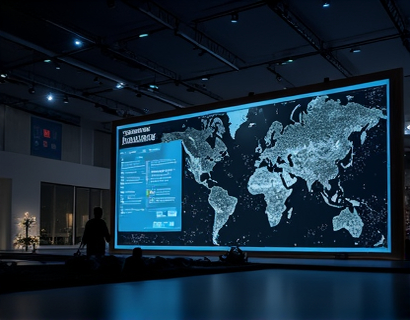Enhancing Global Connectivity with Distributed Network Solutions
The landscape of global connectivity is undergoing a transformative shift, driven by the advent of distributed network solutions. These innovative technologies are redefining how businesses communicate and operate on a worldwide scale. This article delves into the future of global connectivity, exploring the benefits and capabilities of advanced distributed network solutions designed to revolutionize networking for organizations across the globe.
Understanding Distributed Network Solutions
Distributed network solutions refer to a architecture where network components and resources are spread across multiple locations, interconnected through a network. Unlike traditional centralized networks, distributed networks leverage the power of multiple nodes to enhance performance, reliability, and security. Each node in the network can perform specific tasks, process data, and store information, contributing to a more resilient and efficient overall system.
Key Benefits of Distributed Networks
- Enhanced Reliability: By distributing network functions across multiple nodes, the risk of a single point of failure is significantly reduced. If one node fails, others can take over, ensuring continuous operation and minimal downtime.
- Improved Performance: Distributed networks can process data more quickly and efficiently, as tasks are handled concurrently by multiple nodes. This leads to faster data transfer rates and reduced latency, crucial for real-time applications and global communications.
- Scalability: These networks can easily scale to accommodate growing data demands and expanding business operations. Additional nodes can be added as needed, without disrupting existing network functions.
- Cost Efficiency: By optimizing resource utilization and reducing the need for expensive, high-capacity central servers, distributed networks can lower overall operational costs.
Global Connectivity Challenges
In today's interconnected world, businesses face numerous challenges in maintaining robust and efficient global connectivity. These include managing vast amounts of data, ensuring secure communications, and overcoming geographical and infrastructural limitations. Traditional network setups often struggle to meet these demands, leading to bottlenecks, security vulnerabilities, and increased operational costs.
Overcoming Traditional Network Limitations
Distributed network solutions address these challenges by providing a more flexible and adaptable framework. The decentralized nature of these networks allows for better distribution of data and workload, reducing the strain on any single point in the network. This not only enhances performance but also improves fault tolerance and security.
Advantages for Businesses
For organizations looking to expand their global reach and streamline operations, distributed network solutions offer numerous advantages.
Seamless Data Transfer
One of the most significant benefits is the ability to transfer data seamlessly across vast distances. Distributed networks are designed to handle large volumes of data with minimal latency, ensuring that information is transmitted quickly and reliably. This is particularly crucial for businesses engaged in real-time data processing, such as financial institutions, telecommunications companies, and global e-commerce platforms.
Enhanced Security
Security is a paramount concern in global communications. Distributed networks enhance security through multiple layers of protection. Data is encrypted and transmitted across multiple paths, making it harder for malicious actors to intercept or disrupt. Additionally, the redundancy built into these networks ensures that even if one node is compromised, the overall network remains secure.
Improved Disaster Recovery
In the event of a disaster, distributed networks can quickly reroute data and services to alternative nodes, minimizing downtime and ensuring business continuity. This resilience is invaluable for businesses that cannot afford interruptions in service.
Implementing Distributed Network Solutions
Implementing a distributed network solution involves several key steps, from planning and design to deployment and maintenance.
Planning and Design
The first step is to conduct a thorough assessment of the organization's current and future network needs. This includes identifying critical applications, data volumes, and geographical requirements. Based on this assessment, a network architecture is designed that optimizes the placement of nodes and the flow of data.
Node Selection and Deployment
Selecting the right nodes is crucial for the success of the distributed network. These nodes can be physical servers, virtual machines, or cloud-based resources, depending on the specific requirements. Once selected, these nodes are deployed across strategic locations to ensure optimal coverage and performance.
Network Configuration and Optimization
After deployment, the network must be configured to ensure efficient data flow and optimal performance. This involves setting up routing protocols, load balancing mechanisms, and security measures. Continuous monitoring and optimization are essential to maintain peak performance and adapt to changing demands.
Case Studies and Real-World Applications
Several industries have already leveraged distributed network solutions to enhance their global operations.
Financial Services
Banks and financial institutions use distributed networks to process transactions in real-time across different regions. This not only speeds up transaction times but also enhances security and reduces the risk of fraud.
Telecommunications
Telecom companies benefit from distributed networks by providing seamless and high-quality communication services globally. These networks support the growing demand for data-intensive services like video streaming and cloud computing.
E-Commerce
Online retailers rely on distributed networks to manage large volumes of data and ensure fast, reliable service to customers worldwide. This enhances the shopping experience and supports global expansion.
Future Trends in Distributed Networking
The future of distributed networking is promising, with several emerging trends set to further enhance global connectivity.
Edge Computing Integration
Edge computing, which involves processing data closer to the source, is increasingly being integrated with distributed networks. This combination reduces latency and improves response times, making it ideal for applications like IoT and autonomous vehicles.
Artificial Intelligence and Machine Learning
AI and ML are being used to optimize network performance and predict potential issues before they occur. These technologies can dynamically adjust network configurations to ensure the most efficient data flow and resource utilization.
Quantum Networking
Quantum networking, though still in its infancy, holds the potential to revolutionize global connectivity. Quantum networks can offer unprecedented levels of security and speed, enabling new forms of communication and data processing.
Conclusion
Distributed network solutions represent a significant leap forward in global connectivity, offering businesses the tools they need to thrive in an increasingly interconnected world. By enhancing reliability, performance, and security, these solutions are setting a new standard for networking. As technology continues to evolve, the potential for distributed networks to transform global communications and operations is immense.










































